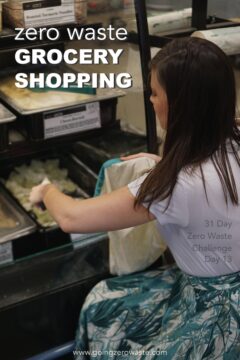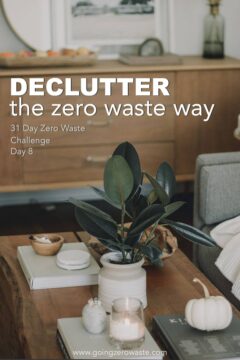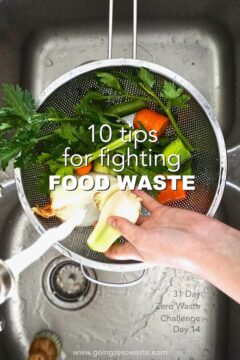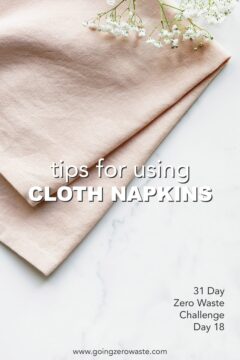Tips for Secondhand Shopping – Day 27 of the Zero Waste Challenge
31 Day Zero Waste Challenge
January 27, 2019 | Guest Post
Last Updated on January 23, 2024
It takes a lot of energy and resources to make new products. Remember when we talked about buying less in day one of the zero waste challenge?
While buying less is certainly part of the solution, so is buying second hand or asking your friends and family if they have an extra one lying around you could borrow and/or have.
Today, I challenge you to shop second hand and purchase products already in the waste stream.
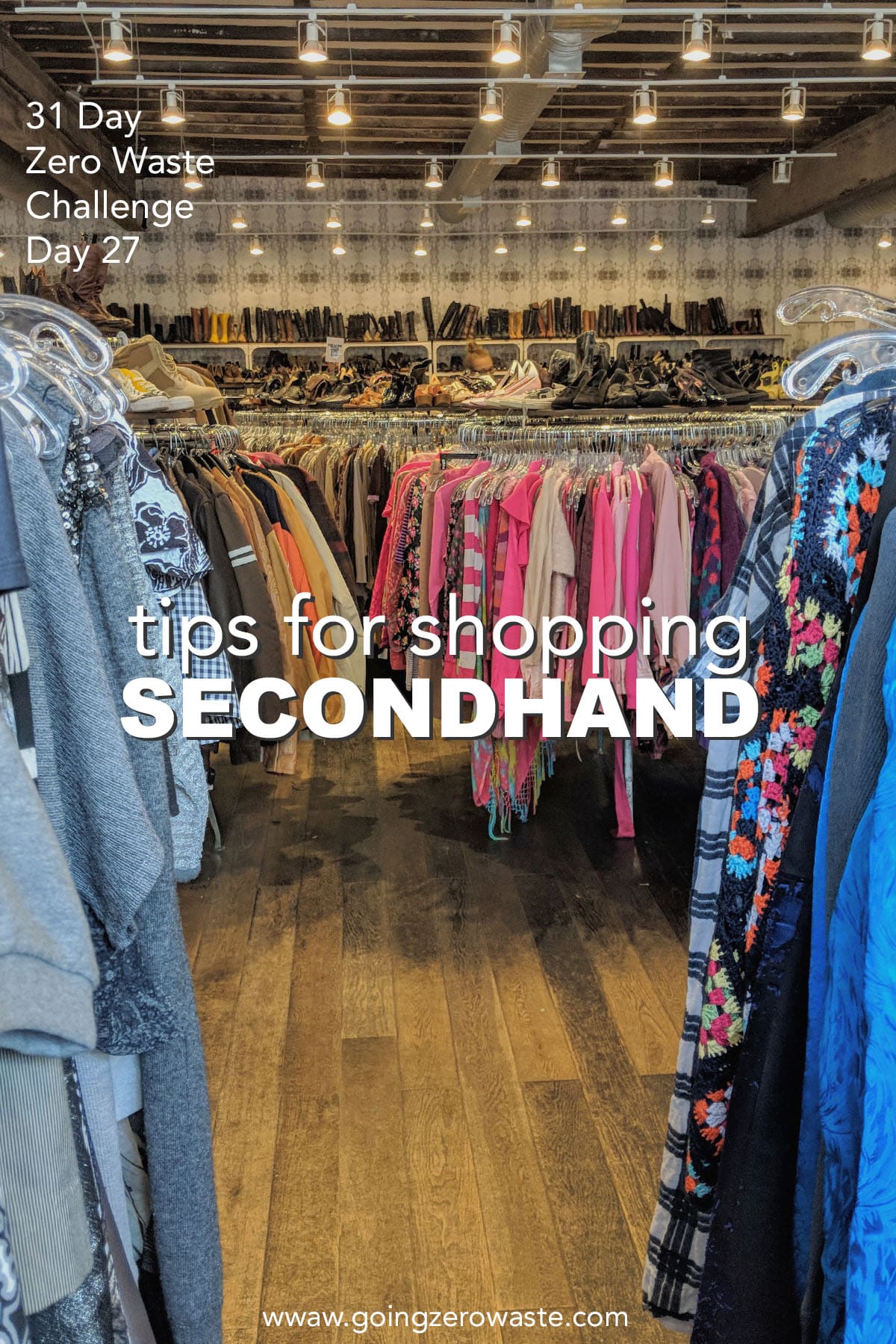
It’s day twenty seven of the zero waste challenge! There’s only four days left of the challenge – we’ve come a long way!
The beginning of the challenge is focused on simple swaps like bringing your own water bottle and bags to the grocery store.
The second phase of the challenge is focused on lifestyle changes like learning to make your own snacks, decluttering your life the zero waste way, and conserving natural resources.
Now, we’re into the third phase of the challenge.
The activism phase. The phase where you get to get a little outside of yourself and work on bringing change at a whole new level.
(I will say a couple of posts are out of order. We had an activism post earlier in the challenge and we’ll have a lifestyle change in this section, but you can forgive me, right!? Thanks 🙂
Today we’re talking about shopping second hand!
Prefer video content? Scroll down to the bottom of the page.
Table of Contents
the problem:
Every item purchased second hand means one less new one produced. Every item, even something small like a t-shirt takes a lot of time, energy and resources.
Clothing, particularly, fast fashion has some questionable ethics, and can be wasteful and harmful to the environment.
Producing synthetic fibers like polyester requires energy and crude oil like petroleum. Yep – polyester is plastic!
Even garments that utilize natural fibers, like cotton, use a ton of water. It takes 27,000 gallons of water to make the cotton for one t-shirt! (source)
Conventionally grown cotton makes up just 2.5 percent of total cropland, but uses 16 percent of the world’s pesticides.
And, if the clothing you’re buying, isn’t made local to you, you also have to take into consideration the fossil fuels used in transportation.
Once we have the t-shirt in our possession, how many times do we wear it?
When does it get thrown out with the next tidying session? One of the biggest problems regarding garments in particular is textile waste.
According to the Ellen Mac Arthur Foundation “Every second, the equivalent of one garbage truck of textiles is landfilled or burned.
An estimated USD 500 billion value is lost every year due to clothing that’s barely worn and rarely recycled. “
Of course, this applies to far more than just t-shirts, but also furniture, jewelry, toys, they all take energy and resources to create.
the solution:
Don’t support this cycle of constant consumption and exploitation of the earth.
Choose to shop second hand instead.
By purchasing second hand, you aren’t supporting this waste of time, energy and resources. In fact, you’re keeping items out of the landfill.
Go visit your local thrift store and see how many items, still in great condition, are being sold.
You’ll be amazed at how much backstory, history and value the items available. You might also find something that truly speaks to you!
You can also find some great second hand things online using ebay or even craigslist.
Even Facebook Marketplace can be a valuable asset in finding things local to you, second hand.
I personally love second hand shopping. So many of my homewares and clothing is second hand.
One of my favorite things about second hand pieces are the stories. You’re part of its story now. And, when you pass it on, maybe it will be part of someone else’s story, and I think that’s really special.
I have a pearl necklace that was my grandmother’s. It started out as a long strand of pearls that were split into six different necklaces for all of the girls in the family.
It’s just so special and buying a new pearl necklace wouldn’t have nearly the amount of warm, fuzzy memories attached with it.
Several other items I wear are second hand too, like my engagement ring and my wedding bands.
I’m telling you – there are so many amazing things on the second hand market.
You also don’t have to actually purchase items in order to support second hand values – you can also get items second hand from loved ones.
Always ask around before buying an item to see if someone has a spare first.
I do link to products that I own, but often times you’ll see me say “please check the second hand market first”. I also love supporting sustainable businesses and think we need both to thrive, but that’s another post for another time.
Of course, some things are better bought new – like a toothbrush. 😉
take the challenge!
Over the next 4 days, your challenge is to shop second hand.
New items take a lot of time, resources, and energy to make.
Instead, choose to buy items that are already out there. This means one less new item will be produced and ensures a perfectly good item stays out of the landfill.
You can find so many things from clothes to housewares on the second hand market: the possibilities are endless.
Will you be taking the challenge?
want more?
Just starting out? Have 1,000 burning questions!?
Get access to my private Facebook group, where I’ll be hosting weekly lives throughout the challenge and I answer all of your most pressing questions.
PLUS! I’ll be sending out a brand new e-book at the end of the challenge called the Game On Handbook which is all about individual ways to fight climate change.
You don’t want to miss it.
miss a day?
- Day 1: Buy Less
- Day 2: Say No to Straws
- Day 3: Bring Your Own Reusable Water Bottle
- Day 4: Zero Waste Coffee
- Day 5: How to Actually Remember to Bring Your Bags to the Grocery Store
- Day 6: Use Real Stuff
- Day 7: Zero Waste Snacks
- Day 8: Declutter Your Life the Zero Waste Way
- Day 9: The Ultimate Guide to Zero Waste Cleaning
- Day 10: How to Compost
- Day 11: Conserve Natural Resources
- Day 12: Pick Up Litter
- Day 13: Zero Waste Grocery Shopping
- Day 14: Fight Food Waste
- Day 15: Meal Prep
- Day 16: Repair Something
- Day 17: Pack a Zero Waste Lunch
- Day 18: Use Cloth Napkins
- Day 19: Bring Home Leftovers
- Day 20: Zero Waste Dishwashing
- Day 21: Recycle the RIGHT Way!
- Day 22: Zero Waste Toilet Paper
- Day 23: Reduce Waste in Your Beauty Routine
- Day 24: Vote with Your Dollars
- Day 25: Be Prepared
- Day 26: Stop Junk Mail
- Day 27: Shop Secondhand
- Day 28: Shop Local
- Day 29: Start a Local Zero Waste Group
- Day 30: Get Involved in Local Government
- Day 31: Do a Trash Audit


